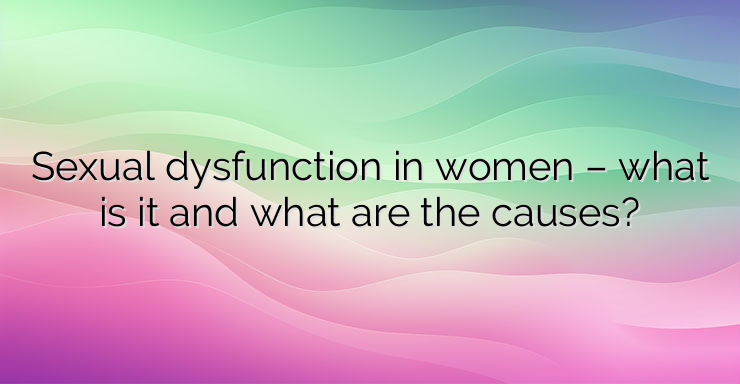The term sexual dysfunction in women refers to persistent problems with sexual desire for at least 6 months, inability to arouse and reach orgasm (anorgasmia) or pain during intercourse (dyspareunia). Difficulties can be due to both an existing health problem and a psychological problem in the relationship between the partners. Whatever the reason for the appearance of sexual dysfunction, the condition significantly affects a woman’s life, which is why timely resolution of the problem is essential for her full life. The causes of sexual dysfunction in women can be divided into several groups: 1. Hormonal causes – low levels of estrogens at the onset of menopause lead to reduced sexual desire and vaginal atrophy, leading to vaginal dryness and difficulties in intercourse. Hormonal changes in women occur during pregnancy, immediately after childbirth and during breastfeeding. Many women during pregnancy report a decreased libido, and after childbirth, the sharp drop in estrogen and progesterone levels, as well as the constant care of the newborn, naturally leads to a decreased sexual desire; 2. Physical causes – this group refers to specific diseases whose pathophysiology or therapy can lead to sexual disturbances. These diseases include kidney failure, malignant diseases, multiple sclerosis, disorders of the cardiovascular system, and bladder problems. Medicines from the groups of antidepressants, antihypertensive medicines, chemotherapeutics, etc. have as an adverse reaction a decrease in libido; 3. Psychological and social reasons – depression, anxiety related to impending birth, problems in relations with the current partner, unpleasant sexual experiences in the past, sexual violence, self-doubt and personal complexes. Decreased sexual desire or frigidity is a condition that develops in women who previously had a normal sex life. It is defined as a recurrent lack of sexual fantasies or a lack of sexual desire. The most common causes of decreased libido are psychological, less often they are hormonal – e.g. in primary or secondary disorders of adrenal function. Arousal disorder is a condition in which the patient has sexual desire, but due to various reasons leading to vaginal dryness, she cannot reach a state of sexual arousal and sexual intercourse is very painful. Sexual dysfunction also includes the inability to reach orgasm (anorgasmia). The causes of anorgasmia can be related to insufficient experience, insufficient sexual stimulation or be psychologically determined. Another form of sexual dysfunction is the appearance of pain during intercourse – dyspareunia. The term apareunia refers to the inability to have sexual intercourse. Common causes of painful intercourse are insufficient arousal,lesions of the vulva, hypoplasia or aplasia of the vagina, large vaginal tumors, inflammatory diseases of the genital tract, etc. The most common symptoms of sexual dysfunction in women are decreased libido, dyspareunia, inability to reach orgasm, decreased sexual arousal. The diagnosis is made after an examination by an obstetrician-gynecologist, accompanied by a detailed anamnesis about the type of complaints, their duration, the patient’s psychological state, pelvic examination, collection of secretions for smear and microbiological examination, ultrasound examination to exclude or confirm organic changes, etc. The treatment of sexual dysfunction in women depends on the cause. In case of hormonal disturbances as a result of menopause, an obstetrician-gynecologist may prescribe the inclusion of local or systemic hormonal therapy, combined with the use of moisturizing agents – lubricants. There are two medications approved by the Food and Drug Administration (FDA) to treat low sexual desire in premenopausal women—flibanserin and bremelanotide. Hormonal changes during pregnancy and after childbirth are a temporary phenomenon and do not need specific therapy. When the condition is related to a psychological problem, consultation with a psychologist or psychotherapist is needed to clarify and treat the trauma. Bibliography: https://www.mayoclinic.org/diseases-conditions/female-sexual-dysfunction/diagnosis-treatment/drc-20372556


Leave a Reply